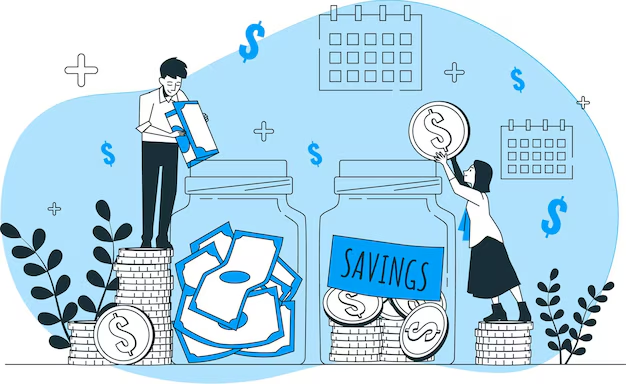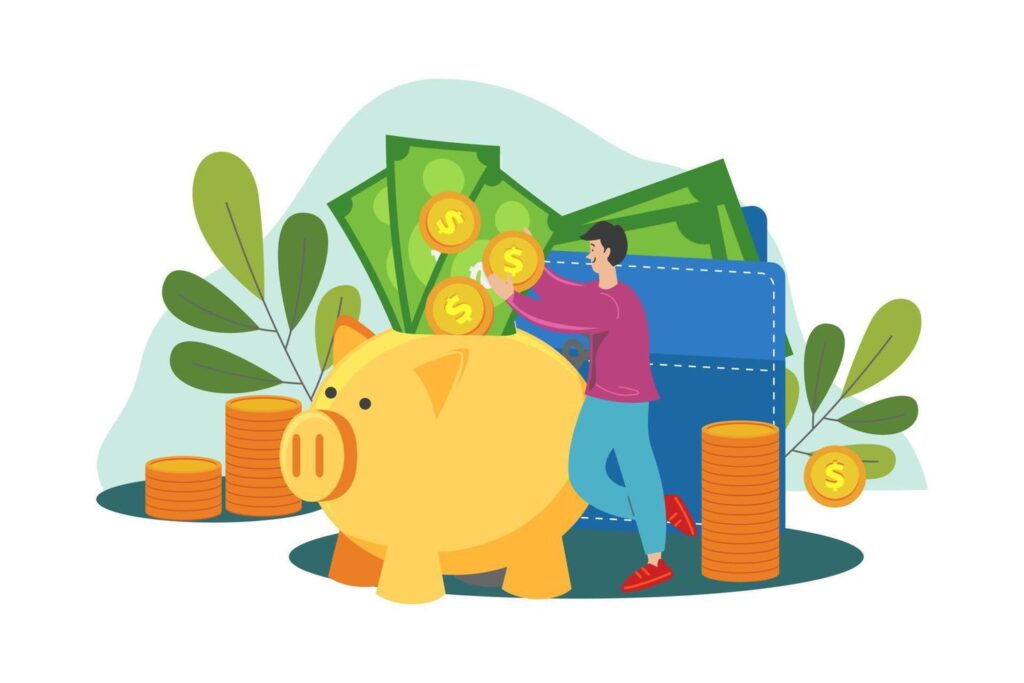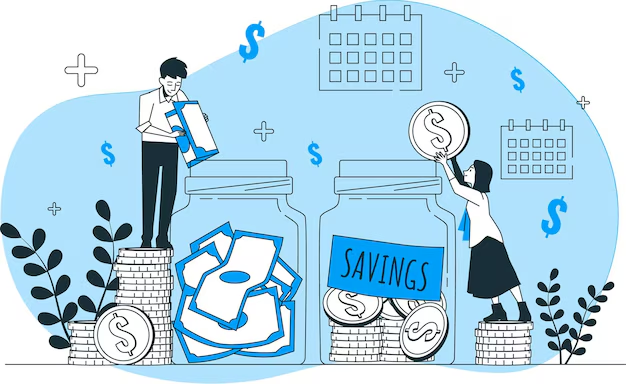Meta Description:
Revenge saving is the hottest personal finance trend in 2025. Learn what it is, why it’s growing, how to start, and expert strategies that even top finance blogs don’t cover.
𝐖𝐡𝐚𝐭 𝐈𝐬 𝐑𝐞𝐯𝐞𝐧𝐠𝐞 𝐒𝐚𝐯𝐢𝐧𝐠 𝐚𝐧𝐝 𝐖𝐡𝐲 𝐈𝐬 𝐈𝐭 𝐏𝐨𝐩𝐮𝐥𝐚𝐫?
Revenge saving is aggressively putting money into savings after a period of overspending, financial stress, or instability. It’s a direct reaction to situations like:
- Job loss
- Unexpected medical bills
- Debt overload
- Global economic uncertainty
Instead of emotional spending (“retail therapy”), you channel your emotions into building wealth and stability.
Why it’s most important in 2025:
Revenge saving is the opposite of revenge spending. After the pandemic (2020–2022), many people spent excessively to make up for lost time—trips, luxury items, dining out. This was called revenge spending.
But by late 2023, reality hit. Inflation stayed high, interest rates increased, and personal debt piled up. Many realized they had little savings and too many financial commitments. The emotional response? Revenge saving—aggressively saving money as a way to regain control, security, and confidence.
It’s not just about building a bank balance—it’s about proving to yourself (and maybe others) that you can bounce back financially.

𝐓𝐡𝐞 𝐍𝐮𝐦𝐛𝐞𝐫𝐬 𝐁𝐞𝐡𝐢𝐧𝐝 𝐭𝐡𝐞 𝐓𝐫𝐞𝐧𝐝.
Recent data shows:
- 37% of Americans are saving more than last year.
- 44% of high earners report increased savings.
- 59% of Gen Z are prioritizing saving over spending.
- National savings rate jumped from 4.1% to 4.9% in early 2025.
Unique Insight: Unlike past savings spikes (which came during recessions), this trend is fueled by proactive choice, not just fear.
𝐓𝐡𝐞 𝐏𝐬𝐲𝐜𝐡𝐨𝐥𝐨𝐠𝐲 𝐨𝐟 𝐑𝐞𝐯𝐞𝐧𝐠𝐞 𝐒𝐚𝐯𝐢𝐧𝐠.
It’s not just about money — it’s about emotions and behavior.
1. Regaining Control
When prices keep going up and the job market feels shaky, saving money is like taking the steering wheel back. You can’t control the economy, but you can control how much you keep aside — and that brings a real sense of power.
2. Rewriting the Story
After a period of overspending or financial struggles, many people want to prove — to themselves and sometimes to others — that they can bounce back stronger. Every dollar saved becomes part of their “comeback story.”
3. Delayed Gratification Mastery
Instead of chasing quick thrills like shopping or luxury dinners, revenge savers choose the long game. They trade small, short-term pleasures for bigger wins later — like debt freedom, a dream home, or early retirement.

𝐁𝐄𝐇𝐀𝐕𝐈𝐎𝐑𝐀𝐋 𝐅𝐈𝐍𝐀𝐍𝐂𝐄 𝐓𝐈𝐏: 𝐔𝐒𝐄 “𝐂𝐎𝐌𝐌𝐈𝐓𝐌𝐄𝐍𝐓 𝐃𝐄𝐕𝐈𝐂𝐄𝐒” 𝐓𝐎 𝐒𝐓𝐀𝐘 𝐎𝐍 𝐓𝐑𝐀𝐂𝐊.
One of the biggest reasons people fail to save consistently is self-control — we start with good intentions, but temptations and sudden expenses pull us off track. A commitment device is a smart, psychological trick you set up in advance to make it harder for yourself to quit.
Think of it as a safety net for your future self.
Examples of commitment devices in saving:
- Auto-Savings Transfers
Set up your bank account so that a fixed amount automatically moves to your savings account every month. Since it happens without you doing anything, you’re less likely to skip it. - Penalty-Based Saving Challenges
Make an agreement with a friend or family member: if you fail to save the promised amount, you owe them money or must do a task you dislike (like cleaning their garage or running an extra 5 km). The fear of losing money or doing that task will push you to stick to your plan. - Locked Savings Accounts
Open a savings account that you can’t touch for a fixed time (like a 1-year fixed deposit). The inability to withdraw stops impulsive spending.

𝐈𝐬 𝐑𝐞𝐯𝐞𝐧𝐠𝐞 𝐒𝐚𝐯𝐢𝐧𝐠 𝐚 𝐆𝐨𝐨𝐝 𝐈𝐝𝐞𝐚 𝐢𝐧 𝟐𝟎𝟐𝟓?
Yes — but with balance.
- Pros: Builds security, reduces anxiety, and improves money habits.
- Cons: Over-restriction can lead to burnout or a spending relapse.
The key is sustainable discipline — steady saving without making your life miserable.
𝐁𝐞𝐠𝐢𝐧𝐧𝐞𝐫’𝐬 𝐒𝐭𝐞𝐩-𝐛𝐲-𝐒𝐭𝐞𝐩 𝐏𝐥𝐚𝐧 𝐟𝐨𝐫 𝐑𝐞𝐯𝐞𝐧𝐠𝐞 𝐒𝐚𝐯𝐢𝐧𝐠.
𝐒𝐭𝐞𝐩 𝟏: 𝐃𝐞𝐟𝐢𝐧𝐞 𝐘𝐨𝐮𝐫 𝐆𝐨𝐚𝐥 𝐂𝐥𝐞𝐚𝐫𝐥𝐲
Example: “Save $5,000 for an emergency fund in 12 months.”
- Break it into monthly targets.
- Track your progress visually.
𝐒𝐭𝐞𝐩 𝟐: 𝐅𝐢𝐧𝐝 𝐚𝐧𝐝 𝐅𝐢𝐱 𝐒𝐩𝐞𝐧𝐝𝐢𝐧𝐠 𝐋𝐞𝐚𝐤𝐬
- Audit last 3 months of expenses.
- Cancel unused subscriptions.
- Compare insurance/utilities for better rates.
𝐒𝐭𝐞𝐩 𝟑: 𝐀𝐩𝐩𝐥𝐲 𝐭𝐡𝐞 𝐌𝐨𝐝𝐢𝐟𝐢𝐞𝐝 𝟓𝟎-𝟑𝟎-𝟐𝟎 𝐑𝐮𝐥𝐞
Traditional: 50% needs, 30% wants, 20% savings.
Revenge saving tweak: 50% needs, 20% wants, 30% savings.
𝐒𝐭𝐞𝐩 𝟒: 𝐀𝐮𝐭𝐨𝐦𝐚𝐭𝐞 𝐒𝐚𝐯𝐢𝐧𝐠𝐬
- Direct deposit a % of salary into high-yield savings.
- Treat savings like a bill you must pay.
𝐒𝐭𝐞𝐩 𝟓: 𝐔𝐬𝐞 𝐍𝐨-𝐒𝐩𝐞𝐧𝐝 𝐂𝐡𝐚𝐥𝐥𝐞𝐧𝐠𝐞𝐬
- 30-day no-spend month
- Cash-only week
- “Buy nothing new” month

𝐇𝐨𝐰 𝐌𝐮𝐜𝐡 𝐒𝐡𝐨𝐮𝐥𝐝 𝐈 𝐒𝐚𝐯𝐞 𝐟𝐨𝐫 𝐑𝐞𝐯𝐞𝐧𝐠𝐞 𝐒𝐚𝐯𝐢𝐧𝐠?
There’s no universal number — it depends on your income, expenses, and goals.
- If you have no emergency fund: Aim for 3–6 months’ expenses.
- If you already have one: Direct extra cash toward debt payoff or investments.
Formula: Monthly Goal = Target Savings ÷ Timeframe in Months.
𝐂𝐚𝐧 𝐈 𝐃𝐨 𝐑𝐞𝐯𝐞𝐧𝐠𝐞 𝐒𝐚𝐯𝐢𝐧𝐠 𝐖𝐡𝐢𝐥𝐞 𝐏𝐚𝐲𝐢𝐧𝐠 𝐎𝐟𝐟 𝐃𝐞𝐛𝐭?
Yes — and you should.
Use the 70-30 split:
- 70% of extra income → debt repayment
- 30% → savings
This ensures you’re building a safety net while reducing liabilities.
𝐔𝐧𝐢𝐪𝐮𝐞 𝐑𝐞𝐯𝐞𝐧𝐠𝐞 𝐒𝐚𝐯𝐢𝐧𝐠 𝐒𝐭𝐫𝐚𝐭𝐞𝐠𝐢𝐞𝐬 𝐘𝐨𝐮 𝐖𝐨𝐧’𝐭 𝐅𝐢𝐧𝐝 𝐄𝐯𝐞𝐫𝐲𝐰𝐡𝐞𝐫𝐞.
𝟏. 𝐈𝐧𝐟𝐥𝐚𝐭𝐢𝐨𝐧-𝐏𝐫𝐨𝐨𝐟 𝐘𝐨𝐮𝐫 𝐒𝐚𝐯𝐢𝐧𝐠𝐬
Use high-yield savings accounts (4%+ APY) or short-term Treasury bills to protect your money’s value.
want to know trustworthy HYSA IN 4 TO 5 % APY= https://smartdollarway.com/high-yield-savings-accounts-no-fees-5-percent-apy/

𝟐. 𝐋𝐚𝐲𝐞𝐫𝐞𝐝 𝐒𝐚𝐯𝐢𝐧𝐠𝐬 𝐀𝐜𝐜𝐨𝐮𝐧𝐭𝐬
Set up multiple accounts:
- Emergency fund
- Big purchase fund
- Investment fund
𝟑. 𝐋𝐢𝐟𝐞𝐬𝐭𝐲𝐥𝐞 “𝐃𝐨𝐰𝐧𝐠𝐫𝐚𝐝𝐞” 𝐄𝐱𝐩𝐞𝐫𝐢𝐦𝐞𝐧𝐭𝐬
Live one income bracket lower for 3–6 months to fast-track savings.
𝟒. 𝐑𝐞𝐯𝐞𝐫𝐬𝐞 𝐁𝐮𝐝𝐠𝐞𝐭𝐢𝐧𝐠
Save first, spend what’s left.
𝟓. 𝐑𝐞𝐰𝐚𝐫𝐝 𝐌𝐢𝐥𝐞𝐬𝐭𝐨𝐧𝐞𝐬
Every time you hit 25%, 50%, or 75% of your goal, allow a small planned treat.
𝐖𝐡𝐚𝐭’𝐬 𝐭𝐡𝐞 𝐃𝐢𝐟𝐟𝐞𝐫𝐞𝐧𝐜𝐞 𝐁𝐞𝐭𝐰𝐞𝐞𝐧 𝐑𝐞𝐯𝐞𝐧𝐠𝐞 𝐒𝐚𝐯𝐢𝐧𝐠 𝐚𝐧𝐝 𝐚𝐧 𝐄𝐦𝐞𝐫𝐠𝐞𝐧𝐜𝐲 𝐅𝐮𝐧𝐝?
Emergency Fund: Money set aside for unexpected expenses.
Revenge Saving: Aggressive saving with emotional motivation, often after a financial setback.
𝟏 𝐑𝐞𝐚𝐥-𝐋𝐢𝐟𝐞 𝐂𝐚𝐬𝐞 𝐒𝐭𝐮𝐝𝐲 𝐢𝐧 𝐎𝐮𝐫 𝐒𝐮𝐫𝐯𝐞𝐲
Anna, 29, New York:
- Lost her job in 2023.
- Spent recklessly for months after for finding new business
- In 2024, started revenge saving: $500/month into a high-yield account + side gig income.
- By mid-2025: Paid off $8,000 debt, built $12,000 savings.

𝐓𝐨𝐨𝐥𝐬 𝐚𝐧𝐝 𝐑𝐞𝐬𝐨𝐮𝐫𝐜𝐞𝐬 𝐟𝐨𝐫 𝐑𝐞𝐯𝐞𝐧𝐠𝐞 𝐒𝐚𝐯𝐢𝐧𝐠.
want to know about more trustworthy budgeting apps in detail with all access = https://smartdollarway.com/top-7-ai-budgeting-tool-2025/
Apps: Mint, YNAB, PocketGuard, Revolut
Bank Accounts: Ally Bank, Marcus by Goldman Sachs, Discover
Trackers: Google Sheets templates, Notion finance dashboards
𝐌𝐢𝐬𝐭𝐚𝐤𝐞𝐬 𝐭𝐨 𝐀𝐯𝐨𝐢𝐝 𝐢𝐧 𝐑𝐞𝐯𝐞𝐧𝐠𝐞 𝐒𝐚𝐯𝐢𝐧𝐠.
- Setting unrealistic monthly targets
- Ignoring small rewards (leads to burnout)
- Not protecting savings from inflation
- Using savings for non-emergencies
𝐌𝐲𝐭𝐡𝐬 𝐀𝐛𝐨𝐮𝐭 𝐑𝐞𝐯𝐞𝐧𝐠𝐞 𝐒𝐚𝐯𝐢𝐧𝐠.
- You must cut all fun expenses — False. Balance keeps you consistent.
- Only rich people can save aggressively — False. Even small amounts add up.
- You can’t save and pay debt at the same time — False. Smart allocation works.
𝟔-𝐌𝐨𝐧𝐭𝐡 𝐀𝐜𝐭𝐢𝐨𝐧 𝐏𝐥𝐚𝐧 𝐄𝐱𝐚𝐦𝐩𝐥𝐞.
Month 1–2: Track Expenses, Set Goal, Open High-Yield Account
- Track Expenses: Write down everything you spend for 1–2 months. This helps you see where your money is going.
- Set Goal: Decide how much you want to save and why — it could be for debt freedom, a vacation, or just financial control.
- Open High-Yield Account: Put your savings in an account that earns more interest than a regular one. This makes your money grow faster.
Month 3–4: Apply 50-20-30 Rule, Start Side Hustle
- 50-20-30 Rule: Divide your income — 50% for needs, 20% for savings, 30% for wants. This keeps your spending balanced.
- Start Side Hustle: Find a small way to earn extra money, like freelancing, tutoring, or selling handmade items. Every extra rupee adds to your revenge saving.
Month 5: Introduce No-Spend Challenge
- Pick a few days (or a week) where you don’t spend money on anything unnecessary. This trains you to control impulsive spending and boosts your savings.
Month 6: Review, Adjust, and Celebrate Milestones
- Review: Look at how much you saved and if you’re meeting your goals.
- Adjust: If you overspent or saved less, tweak your plan to improve.
- Celebrate Milestones: Reward yourself (within limits!) for sticking to your plan. Celebrating keeps you motivated.

𝐅𝐀𝐐.
Q1: Is revenge saving a long-term strategy?
A: Yes, but it’s most effective as a “reset” before transitioning to regular saving.
Q2: Should I invest during revenge saving?
A: Only after you have an emergency fund and manageable debt.
Q3: Can I start with $50/month?
A: Absolutely — consistency matters more than size at the start.
𝐅𝐢𝐧𝐚𝐥 𝐓𝐚𝐤𝐞𝐚𝐰𝐚𝐲.
Revenge saving in 2025 is more than a money trend — it’s a mindset shift. By combining emotional motivation with proven financial strategies, you can turn a setback into a launchpad for financial independence.
Start now, start small, but stay consistent. Your future self will thank you.

